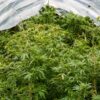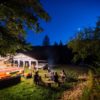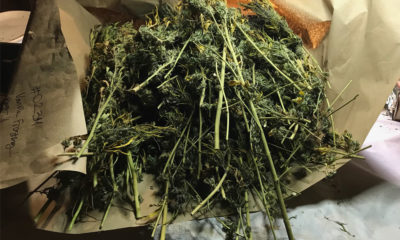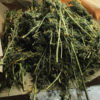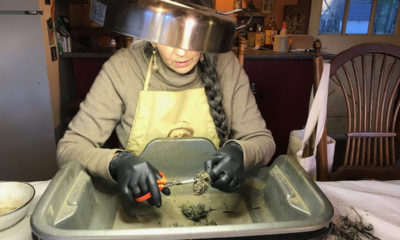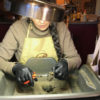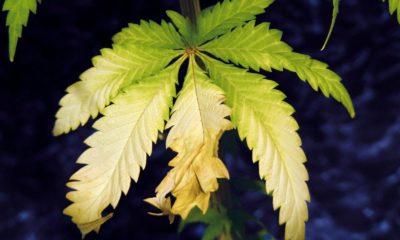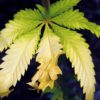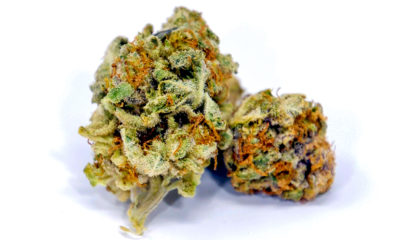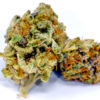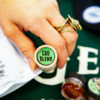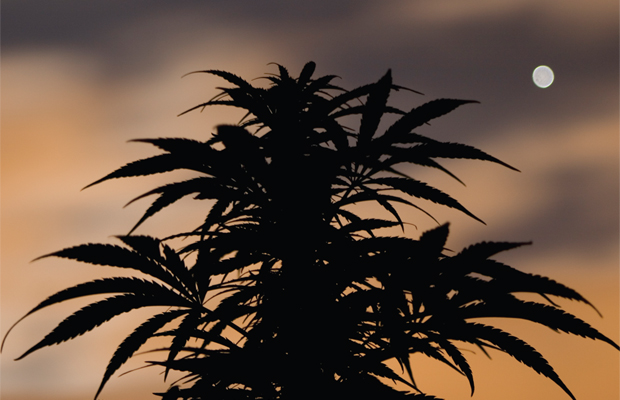
Grow
Roughing it: Harvest at a Trinity Guerrilla Grow
Let’s begin with how to get there. Drive five hours north, over the Golden Gate Bridge, through the treed cathedrals of Richardson Grove, past the dwindling tempo of towns advertising turkey bags, trimming scissors, and drying racks to Arcata.
From there turn right and up, through even bigger trees and nauseating bends over dizzying heights, further and further into the undisputed arboreal kingdom. Go twenty miles and take a certain left, along a hairpin road with treacherous slopes and murderous turns, switching back and forth to the top of a towering ridge, and finally down into a bobbypin valley on the western edge of Trinity County, the wildest of the continental west. Here you park, but you’re still not done. From there it’s canoe over a lazy river, then scrambling on foot over faithless rocks to the barest of trails aimed almost straight up, clinging from tree to tree for two miles to an abandoned mining road which takes you all the way to the precipitous drop-off which is the journey’s final leg. If you can scramble, scurry, and slide this slippery slope another two thirds of a mile down an undulant mountain spur, you might hear the trickle of a cold water spring. Finding that spring, you find a garden, tucked in the endless silent forest, with four hundred eighty massive trunks of marijuana. “Welcome,” said Mike to me when I first made it there, “to growing at its most guerrilla.”
By then it was harvest time, the end of a long labor. On the steep clearing, terraces had been dug. A modern irrigation system distributed both water and amendments directly to the roots of each plant. Between four tall trees, a crew of two had spread a large sheet of black plastic, providing protection from fog, rain, and sun while sheltering a crisscross of airplane cable tied between the oaks, a setup which could dry 250 whole plants at a time. There was ample provision for food, a .40-caliber handgun (just in case), and plenty of ganja to smoke. Just downhill of a prominent boulder, someone had leveled out just enough space for three human sardines side-by-side, because going up there was never just a day trip. No space for a tent, so at night nothing impeded the grand celestial symphony, and the hush settled like a blanket over the night was so vast, the light touch of a fallen leaf echoed off the trunks.
In the mid-fall of 2011 I took the Greyhound up to Arcata on a tip from a friend; there a girl from the camp picked me up and took me back to camp. Almost as soon as I arrived the grower (let’s call him Mike) asked me if I was any good on a hike. I shrugged. Not bad. “Let me see your boots,” he said. I had brought my best pair of hiking boots, and showed them off with pride. Mike inspected the soles and shook his head. “We’ll have to get you a better pair. It’s no joke up there.” Whatever, I thought.
The next morning, four of us stood at the ready, strapped to large, mostly empty backpacks. Besides Mike and myself, there were two young women from Alaska, “Courtenay” and “Drew”. Everyone looked sturdy enough. While the trim crew wished us luck, we set off. It was a steep drop to the river, but the other side was steeper. After forty minutes our group had huffed our way up to the mining road, ready to take a good long stretch. Mike lit up a joint and as we passed it around, he gave the lay ahead. “Now we’ve got just one long steady slope up for just over a mile. This whole thing was built because of all the gold deposits in these mountains, but the last guy to use the mine moved out five years ago, and now no one uses it but us. Let’s go.”
The sun climbed with us. After about a mile of careful weaving through the woods, Mike declared another smoke break. The mood turned lively and fun. As the joint got passed around (Bubba Kush – freshly cured), Mike asked about a knife on Courtenay’s pack. Courtenay proudly drew it, an eight inch Bowie with a serrated edge, passing it around. Everyone agreed it was badass. “Real handy,” laughed Mike, “in case you run into a mountain lion up here.” “There’s a mountain lion right there,” said Drew, casually. Silence. Then: oh my god, she’s right: one very large cat – no more than fifty feet distant. It stood pointing to our left, its one hundred twenty pound body displayed for us like a textbook illustration. Noticing its intense focus, I became suddenly conscious of how careless we had been. The cat took a few steps, made sure we were watching. We were. “That’s a big fucking cat,” Mike finally said.“You’ve seen this before.” I said, optimistically. “Yeah, but I’ve never seen a lion behave like this. He’s acting awful bold.” He was right. Mountain lions tend to stay away from humans, but this one seemed to be taking careful pains to appear conspicuous. Almost like a challenge. Its point made, the cat walked unhurriedly away. We could only stare. It stopped to turn four or five times, as if to make sure we were still watching, then finally disappeared around a bend a hundred yards distant. Everyone squealed.“What was he doing?” I turned to Mike. “Conveying a message,” he said with finality. “He’ll always know where we are, but we’ll only see him when he wants us to.” It was a sobering thought. “Well, good thing we’re not following him.” He pointed downhill. “The patch is down that way, where he came from.” “Where he came from?” I asked. “What do we do if…” Mike stared blankly. “If what?” “Well, if we’re going to do work down in a patch which is down from where he came, and he, ah, thinks of that patch as, um, his territory?” A pause. “What can we do?” Mike shrugged. “I’ve got a forty caliber down at camp. Stashed it for bears. We’ll see.” He shouldered his pack and started down. I followed with knocking knees. Mike pointed downhill. “If you slip, slide on your butt and keep your feet ahead of you. There will be a tree. Eventually.” With that, he went. I made it about twenty feet. The next hundred I passed on my ass, trying in vain to stop myself on the leafy slope. True to Mike’s word, however, an oak did appear. Eventually. I looked up. “Good one, bro!” Mike cheerfully volunteered. “Saved yourself a piece of walking.”
The rest of the descent went like that. We followed a slippery spur of the mountain down about five hundred yards, stepping, slipping, and sliding our way down. At times the grade would be forgiving enough, letting my heavy boots find an akimbo purchase behind an occasional jutting rock or tuft of grass. At other points it seemed hopeless. I slipped into a cautious pace and fell behind the two Alaskan girls. At last we spotted what Mike called Indian Camp: a platter-shaped outcropping that represented the most level ground for a mile any direction. Not that it was exactly flat, but at the end of an endlessly slippery two miles of mountain, the grade of this grove looked practically luxurious. After one last slope we stood on the knoll, looking around.
It was spectacular. Far below us the river undulated through wooded crags toward the ocean; above us the sky sparkled with an azure sheen. All around, not a sound could be heard, not even a bird. We had the whole forest to ourselves. I stretched long and hard, looking for the patch. “Oh, no, not there yet,” said Mike. “Still two hundred yards down the mountain. I hope you saved your strength, because this next part is the most difficult.”
After a brief discussion it was decided that the girls probably wouldn’t make it. As poorly as my boots had performed, at least they were hiking boots. Drew had sneakers, and Courtenay’s soles had the gripping power of a legal pad. “Looks like it’s you and me, buddy,” Mike grinned. Now, I consider myself an experienced if not expert hiker, but that slope made me its bitch. I scrambled. I stumbled. I caused a minor avalanche. I slipped and slided until the seat of my jeans had crossed from blue to brown. And Mike didn’t wait. After about an hour of struggle alone in darkness, I finally saw a light ahead. By the time I collapsed in the narrow aft side of a boulder Mike called a “camp,” it had been dark for two hours. As I drifted rapidly into sleep I pictured the lion again, trying not to think about rude awakenings.
Morning gave me a chance to look around. In all directions, Mike had cut stairs going up and down the slope. Following them about eighty feet just to the boulder’s south, I found about a dozen crude terraces cut into the hillside. On each one grew forty or so cannabis plants in full flower. Instinctively I ran through the calculations. The plants looked like they’d yield between eight ounces to a pound each; averaging three QPs per plant, and forty plants per row, and twelve rows… that makes three hundred sixty pounds. Unload them wholesale in-state at two thousand apiece, and you’ve got three quarters of a million bucks in the ground. Move them to the east coast, and you’re talking two million. Gazing at the patch, in a mild state of shock, I could understand the brilliance of the business model. This was a valuable crop, to be sure; but who’d be crazy enough to try to steal it, even if they could find it? But Mike wasn’t paying me to think. “Time to go to work,” he said, handing me a sturdy pair of clippers. ‘A’ buds came first. ‘B’ buds also worked, so long as they were ‘B plus’. Anything smaller, and the labor budget would kill his margin. As a hike-worker, I got offered a $300 per diem, and $50 for every pound of saleable dried bud I hiked back to camp – making sure my financial interests were more or less aligned with the total operation. So I went to work. My first task was to find plants which would be promising candidates to hang up on airplane cables: low incidence of mold, a decent spread of ‘B’ buds. I clipped them at the base and hung them whole; soon the shade structure had been almost filled with such plants, two hundred in total. After drying, they’d be much easier to haul back to camp. The sun had started its descent by the time I filled up the make-shift dry shed. Then Mike got me ‘bucking’, the process of clipping saleable buds off of clipped branches, readying them to dry before the final trim. We worked furiously, knowing that time was not on our side: once harvested, fresh bud would spoil if not taken quickly to the drying rack for curing. So even while the sun dropped into night, he and I worked with headlamps, snipping bud into makeshift canvas bags.
After bucking two full loads, we made ready to haul them to the girls up the hill. Mike tied off the last strap of one huge bag of weed to an aluminum frame backpack and beckoned me over. “See how that does you,” he said cheerfully. I lifted the pack, stepped under it. Squeezed my shoulders through the arm straps, clicked the belt around my waist. Bounced under the weight once or twice. “It’s… okay? How much is it?” “About fifty pounds.”
I said I could do this. “Let’s go then.” Strangely, the way back up the slope, complete with fifty-pound pack, was easier than the way down. I suppose that the upward slope made it easier to find toeholds, so the only real challenge was to keep moving up, no matter what. The two hundred yards to Indian camp passed by in only forty minutes. Leaving the second load for the girls to trim overnight, Mike and I returned to the patch, now more than half cleared. We would definitely finish the next day.
I lay my sleeping bag out next to the boulder and fell into an exhausted sleep. I awoke with a start. Something I couldn’t place. It sounded like a party – people screaming and shouting with excitement. But what was that short, loud noise? It sounded like a – then it echoed again. A gun shot. And the screaming was not of excitement –they were screams of terror. Indian Camp was in some deep shit. I raised my head. Mike was still asleep. What the hell? I sat up in my sleeping bag. The screams from the girls coming much clearer now, I shook Mike urgently. He stirred slowly. Indignantly: “What?!” “I heard gunshots from Indian Camp. The girls are screaming!” He woke up, quick. “Gunshots?” Their screams became clearer now. They were shouting in unison: help! “Oh, fuck,” said Mike. A long pause. Mike: “Well, fuck it. I’m not going up there to get killed. What the hell do they expect us to do? They’re the ones with the gun.” I blinked. “We don’t have a choice, man! They need our help.” I packed up my backpack, made sure it had my first aid kit. I had my headlamp and boots on while Mike was still getting dressed. He said as long as I’m ready first, I might as well go on ahead, since I’m slow. The hike rushed by in tunnel vision. I got two-thirds of the way up before Mike passed me. He was only thirty feet ahead when he mounted the last crest, did a quick head count, and shouted back in relief: “Thank God. They’re all alive.”
Drew rushed at us while Courtenay – the one with the knife – stood glaring into the gloom beyond the throw of her headlamp. Mike stepped up, took the gun from her. I stared too, at two eerie eyes glowing blue in the gloom. Mike tried to train the pistol on them, but the animal was too far away – only four bullets left, and no extra clip. He stepped aside for a moment, but I remained, transfixed on this animal just outside the edge of my light. It seemed hesitant for a moment. Then it started to move. Toward us. “Um, Mike,” I stammered at him. “It’s headed right this way!” Finally Mike was beside me. “I see it. It’s coming into line of sight.” A pause. “I have a shot.” “Take it!” I screamed, a little hysterically. But Mike hesitated. Closer the eyes crept, until I began to make out the animal’s form. It was very big, standing tall at the shoulder and showing a substantial torso through the gloom. I saw it step toward us, its graceful hoof finding the rock. A hoof! I let out a gasp of relief “Aw, Christ,” said Mike, lowering the pistol. “It’s just a fucking deer.” Then there it was, broad antlers in the gloom, curious nose twitching at us, terrifying eyes shown glossy and dumb in the flashlight. It crept closer still, within twenty feet, then suddenly got spooked and went crashing through the trees.
We stuck together that night. With first light, Mike and I made quick work of the remaining plants, loaded up, and before it even fell dark we had found our way back to the river, every ounce of weed still intact. Mike paid me for the hike plus a small advance against the herb I hauled off the hill – once the haul was dry he would mail me a cashier’s check for the rest (which he actually did). I took the cash and found the first ride out of the valley.
Written by Patrick Baker for Issue 3 of Cannabis Now Magazine.




